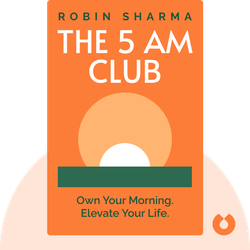Try Blinkist to get the key ideas from 7,000+ bestselling nonfiction titles and podcasts. Listen or read in just 15 minutes.
Start your free trial
Blink 3 of 8 - The 5 AM Club
by Robin Sharma

Five Essential Skills to Overcome Defensiveness and Build Successful Relationships
Radical Collaboration by James W. Tamm and Ronald J. Luyet is a business book that provides tools and techniques for developing trusting, productive relationships within teams and organizations. It emphasizes the importance of effective communication, inclusion, and problem-solving as key elements of successful collaboration.
The modern business world is highly interconnected, with teams spread across the globe that, with the use of online communication, can nevertheless collaborate with one another as if they were neighbors. As such, it’s more important than ever to have great collaborative skills.
So without further ado, let’s look at five essential skills that every great collaborator should have – skills so useful they’ll not only improve your business relationships, but your personal ones as well.
Every great collaboration needs to start with the right motives, which is why the first skill is collaborative intention which refers to having the right mindset for collaboration.
To make sure you have the right mindset, you’ll want to make sure to avoid the red zone and stay in the green zone.
The red zone is a place of defensiveness, where people are mostly driven by a sense of self-interest and the will to outshine everyone else. When you’re in the red zone, you’re not thinking about creative resolutions or how to find win-win situations; instead, your selfish desires will create conflict.
Where you want to be is in the green zone, where your mind is focused on cultivating successful, long-term collaboration, and everyone is driven by open and cooperative values. People in the green zone are opposed to selfish gains and are instead driven to find solutions where everyone comes out ahead.
However, it’s all too common for people to mistakenly think they’re in the green and unconsciously sabotage a project by being in the red.
This is why it’s important to always be honest with yourself and reflect on your own attitude while being open to feedback from your colleagues.
A helpful exercise is to ask your teammates for ten words that best describe your attitude or style.
What you want to be on the lookout for are words like “defensive,” “closed,” “anxious” or “competitive,” as these are telltale signs that you’re in the red zone. You can also ask your colleagues to inform you when you’ve mistakenly made a huge deal out of a small incident, as this will also help you stay firmly in the green.



Radical Collaboration (2004) offers invaluable methods to help you build effective and high-functioning collaborative relationships, as well as strategies to manage any kind of conflict that you might run into. At the heart of these methods are five skills that can turn anyone into a better teammate and turn any organization into an efficient and productive partnership.
Radical Collaboration (2003) explores the concept of collaboration and offers practical strategies for building successful partnerships. Here's why this book is worth reading:
Defensiveness is a poison pill to good relationships. In conflict, defensiveness is like blood in the water to a shark.

It's highly addictive to get core insights on personally relevant topics without repetition or triviality. Added to that the apps ability to suggest kindred interests opens up a foundation of knowledge.
Great app. Good selection of book summaries you can read or listen to while commuting. Instead of scrolling through your social media news feed, this is a much better way to spend your spare time in my opinion.
Life changing. The concept of being able to grasp a book's main point in such a short time truly opens multiple opportunities to grow every area of your life at a faster rate.
Great app. Addicting. Perfect for wait times, morning coffee, evening before bed. Extremely well written, thorough, easy to use.
Try Blinkist to get the key ideas from 7,000+ bestselling nonfiction titles and podcasts. Listen or read in just 15 minutes.
Start your free trial
Blink 3 of 8 - The 5 AM Club
by Robin Sharma
What is the main message of Radical Collaboration?
The main message of Radical Collaboration is that working together in a collaborative and open manner leads to better outcomes and relationships.
How long does it take to read Radical Collaboration?
The reading time for Radical Collaboration varies, but it typically takes a few hours. However, the Blinkist summary can be read in just 15 minutes.
Is Radical Collaboration a good book? Is it worth reading?
Radical Collaboration is definitely worth reading. It provides valuable insights and practical strategies for improving collaboration and fostering positive relationships.
Who is the author of Radical Collaboration?
The authors of Radical Collaboration are James W. Tamm and Ronald J. Luyet.